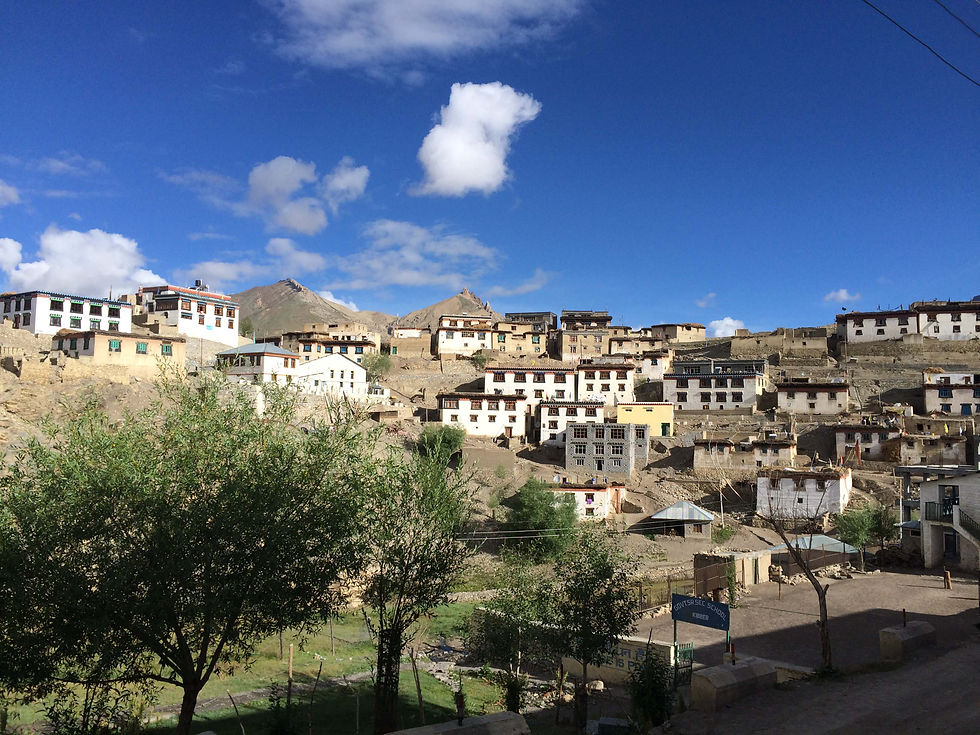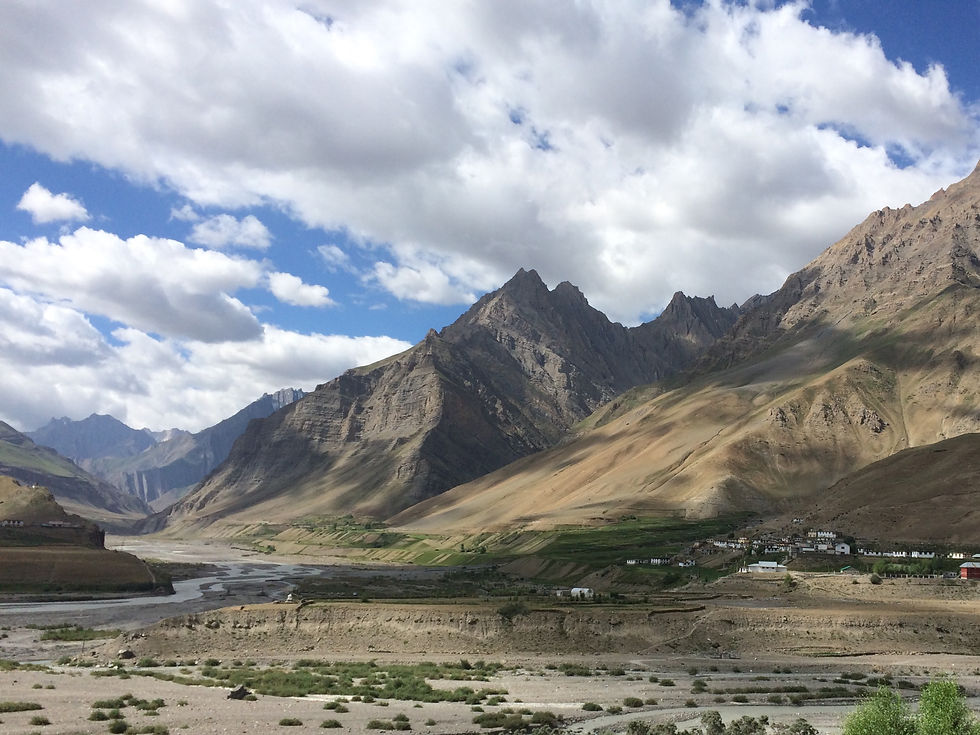Slippery and Strange: How Stories Transfigure and Why We Should take Them Seriously
- Jane Orton
- Oct 10, 2022
- 6 min read
Updated: Sep 17, 2024
In the high-altitude Himalayan desert of Spiti, strange entities are said to lurk beneath the everyday world and you must appease local spirits with animal horns left on chortens. Stories of these often transfigure from one village to the next. Dr. Orton explains her approach to these stories, and why we should take them seriously.

Word Gets Round
Waking up in Kibber village in the Spiti region of the Indian Himalayas, 4000 metres above sea level, it is common to hear villagers calling to each other across the concavity that divides the village. Voices carry clearly and it is much faster to call out than to walk around to the other side of the village.
News travels fast here, faster than people do. I’ve sometimes been amazed that news of the ‘red haired foreigner’ has arrived in the village even before I do, although it is two hours by road to get to Kibber from the region’s capital Kaza and, at least when I first visited, phone reception was almost non-existent. At that time, there was a single place in Kibber that could get mobile reception if you were to balance the phone on one of the windows at one restaurant at a particular angle.
Word gets round in this part of the world, yet stories transmute from one village to the next. One might be told in Chicham village that the Kibber village god is the most powerful, having tricked the Chicham god out of his power – only to be told in Kibber that the Langsa god is the cunning one and that Kibber’s god is a servant of Chicham’s. In Kibber, one might be delighted to discover that the secret to entering biyul (hidden lands) is to be para momo (to have fear), only to be told in Pin Valley, that to be para momo is actually unlucky and that it does not even mean that you can see biyul.
Stories are Slippery and Strange
Stories in Spiti are hard to pin down. Balu Tukangbu is a wish granting entity that is said to live in the Himalayas, a little man who is one foot tall, with the strength of a bear. He wears a hat that is one foot tall and carries a stick that is one foot tall. He is invisible to some people, but if you catch him and take his hat and his stick, he can grant any wish. There are tales of Balu across the Himalayas– in Spiti, the details of these narratives both transmute and repeat some elements consistently.
Balu certainly seems to be averse to being caught – and for good reason. At Kee Old People’s Home, one of the residents told me that in early times, Balu used to play in Kee pond until some of the villagers tried to catch him. After that, he was afraid and did not want to come back. In Kibber, I was told that someone from Kibber itself managed to catch Balu, and kept him under the sink as a kitchen slave for a decade.

In Sagnam village, though, I heard that it was actually someone in Demul village who managed to get hold of him and kept the stick in a place too high for him to reach. The person kept him as a servant for many years. One day, everyone was in the fields ploughing and Balu was sent to get a stick from the village. An old woman gave him his own stick, allowing him to escape and curse the village.
Generally, in Kibber valley, it is said that Balu comes from a place just above Gete village, and it is agreed here that if you are para momo, you stand a chance of seeing and catching him – but in Pin Valley, they say Balu comes from a biyuland that being para momo will not help you to catch him.
Stories Echo
Stories are slippery things, but there is a consistency to them – a rhythm that plays out across the vast empty spaces of the Himalayan desert. Spend enough time in the region and you will hear kyakshung (short stories one might tell over tea), namthar (long religious stories), etiological narratives, lakshung (fairy tale-like stories that are influenced by Indian and Tibetan narratives), saint’s legends, proverbs, local lore and gyalshung (stories, told by song in winter, for bedtime entertainment). Listen to enough stories, and you will find that some motifs echo across the different narrative forms.

The same motif of taking refuge in the horn of a wild ungulate appears in local lore, retellings of saints tales from the Tibetan Buddhist cannon and lakshung. In Kibber, I was told that the tantric saint Milarepa once took refuge in a yak horn, echoing the Story of the Yak Horn from the Tibetan Buddhist cannon.
According to Tsangnyön Heruka’s canonical account of the story, Milarepa is able to hide in the horn without making the horn bigger, or becoming smaller himself, “like the image of a mirror and with a quality of expansiveness.” His disciple Rechungpa tried to go inside the horn, but not even his head would fit.
The same motif of taking refuge in the horn of a wild ungulate repeats across different kinds of narrative in Spiti. I was told a lakshung in Kibber village in which a monk uses his power to hide a man in the horn of an ibex from jealous, angry villagers. In Chicham village, I was told of a wild sheep in early times who came into the region with horns so big that a fox lived inside them.
Heed These Stories
Anthropology has a shameful history of European academics writing about other cultures from the outside, as though the people who live in these communities are primitive objects of study (click the link to read about how my research in Berlin challenges this). Rightly, the discipline has undergone a process of critical self-reflection, in which local people are seen as collaborators in building the anthropologist’s or folklorist’s account.
When collecting local narratives, it is important not to write off inconsistent accounts or to strive to eliminate the ‘wrong’ version. We do not necessarily have to embrace a post-modernist view that truth is relative, although that is a popular view in anthropological circles. What we must do, though, is prioritise the voices of local people.

However much the details change or whatever form the narrative takes, there is a consistency to these stories, and you would do well to take heed. I was told by one of the monks at Kee monastery that a yak chose the location of the monastery and they told me at Kee Old People’s Home that a spirit in the form of a yak saved the monastery from robbers with a wave of its tale. In the Tsechu festival, yak and ibex masks are worn to perform the protective cham dance and blue sheep horns are installed on shrines as offerings and receptacles for local protective deities. The message is clear: horned mammals offer protection.
Heed these stories, no matter how slippery or strange: it might also do you good regardless of your anthropological ambitions. My friend and translator Tenzin once told me a story that has always stuck with me: the Spirit of Losar and Hansa does not like the people at Kinnaur. Even now, taxi drivers refuse to play Kinnauri songs on their way through. At a party in Losar, after a cricket match in Hansa, Tenzin and his friends forgot this, and decided to play Kinnauri music on their mobiles. Their phones froze until the morning.
As the stories say, it is always best to appease the deities.
Find Out More
To learn more about Dr. Orton’s research in the Himalayas, read her blog posts, Of Mountains, Wishes and Hidden Places, The Leopard and the Spotters and The Desert that Would not be Tamed. If you’d like to learn more about Himalayan Folklore, look at our Anthropology courses, Religion of the Himalayas, Himalayan Folklore or Tibetan and Himalayan Studies. Alternatively, if you’re interested in how local narratives can support efforts to conserve local wildlife, take a look at our Interdisciplinary course, Culture and Conservation.
These courses are templates of possible routes of study and can be combined, adapted, or designed from scratch to suit your interests and goals. Dr. Orton will work with you to design a course of private tutorials tailored to your needs, ability and schedule – whether you are undertaking your own research for an independent project, writing a book or simply have a personal interest. Find out what it’s like to work with her and contact us to find out more!
Undertake Your Own Research Project in Anthropology and Religious Studies
Working on your own independent research project needn’t be a lonely task: Dr. Orton works with other independent scholars on projects in conservation and the humanities. Contact us for a chat with her.
If you’re not ready to reach out yet, follow our research methods series on this blog for more ideas! Dr. Orton has written posts on the importance of independent research and how to get started with building your own approach to ethical, people-centred fieldwork.
Reach Out
Follow us on Orton Academy Instagram to see pictures from Dr. Orton’s fieldwork in the Himalayas and the Sundarbans – we would love to connect with you!

Comments